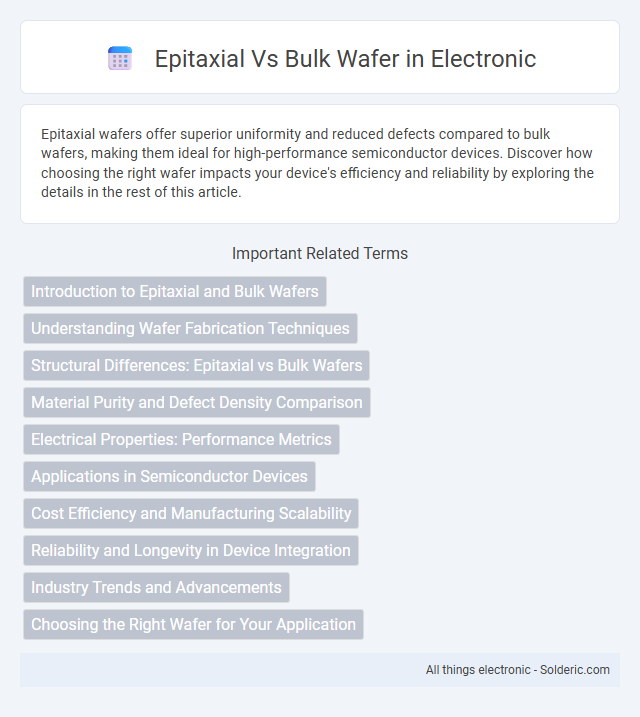Epitaxial wafers offer superior uniformity and reduced defects compared to bulk wafers, making them ideal for high-performance semiconductor devices. Discover how choosing the right wafer impacts your device's efficiency and reliability by exploring the details in the rest of this article.
Comparison Table
| Feature | Epitaxial Wafer | Bulk Wafer |
|---|---|---|
| Definition | Thin layer of single-crystal silicon grown on a bulk wafer substrate | Single-crystal silicon wafer made from a solid crystal ingot |
| Layer Structure | Multiple layers with precise doping control | Uniform doping throughout the wafer |
| Thickness | Typically 1-50 micrometers | Typically 300-800 micrometers |
| Create Defects | Lower defect density due to controlled growth | Higher intrinsic defect density |
| Applications | High-performance ICs, RF devices, power semiconductors | General-purpose semiconductor fabrication |
| Cost | More expensive due to complex process | Less expensive manufacturing |
| Surface Roughness | Smoother surface aiding device fabrication | Rougher surface compared to epitaxial layers |
| Doping Control | Precise doping profiles possible | Limited doping control |
Introduction to Epitaxial and Bulk Wafers
Epitaxial wafers consist of a thin, single-crystal layer grown on top of a bulk substrate, offering superior electrical properties and enhanced control over doping profiles. Bulk wafers are made entirely from a single crystalline material, providing structural foundation but less flexibility in tailoring device characteristics compared to epitaxial layers. Your semiconductor device performance can greatly benefit from choosing epitaxial wafers when precise control of electrical parameters is crucial.
Understanding Wafer Fabrication Techniques
Epitaxial wafers are created by depositing a thin, highly controlled semiconductor layer atop a bulk wafer substrate, enhancing electrical properties and enabling precise device performance. Bulk wafers consist of a single crystal silicon slice, offering cost-effective fabrication but with less control over doping profiles and defect densities. Choosing your wafer type depends on the required device characteristics, production scale, and performance specifications in semiconductor manufacturing.
Structural Differences: Epitaxial vs Bulk Wafers
Epitaxial wafers consist of a thin, highly controlled crystalline silicon layer grown atop a bulk silicon substrate, allowing precise doping profiles and superior material uniformity. Bulk wafers, in contrast, are single-crystal silicon slices harvested directly from ingots, offering uniform intrinsic properties throughout the entire wafer thickness. The structural distinction lies in epitaxial wafers having a distinct top layer engineered for specific electronic characteristics, while bulk wafers present a homogeneous crystalline structure.
Material Purity and Defect Density Comparison
Epitaxial wafers exhibit higher material purity with fewer unintended impurities compared to bulk wafers, as they are grown layer-by-layer on a substrate under controlled conditions. This method also results in significantly lower defect density, such as dislocations and stacking faults, enhancing electronic device performance. Bulk wafers typically have higher defect densities due to the nature of their bulk crystal growth, which can include impurities from the melting process.
Electrical Properties: Performance Metrics
Epitaxial wafers exhibit superior electrical properties compared to bulk wafers, including lower leakage current and higher breakdown voltage, resulting from their controlled, defect-free crystalline layers. The reduced defect density in epitaxial layers enhances carrier mobility and reduces parasitic capacitance, improving device speed and efficiency. Your semiconductor devices benefit from these performance metrics, achieving higher reliability and faster switching speeds in high-frequency applications.
Applications in Semiconductor Devices
Epitaxial wafers are primarily used in high-performance semiconductor devices such as integrated circuits, power devices, and advanced sensors due to their superior crystal quality and controlled doping profiles. Bulk wafers, with their lower cost and simpler manufacturing process, are commonly employed in standard digital and analog electronic components where extreme precision is not as critical. The choice between epitaxial and bulk wafers directly impacts device reliability, speed, and power efficiency in applications like microprocessors, RF amplifiers, and LEDs.
Cost Efficiency and Manufacturing Scalability
Epitaxial wafers offer higher cost efficiency in advanced semiconductor applications by enabling precise control over layer thickness and doping, reducing defects and enhancing device performance, which minimizes material wastage and processing time. Bulk wafers, while generally less expensive per unit, may incur higher overall costs due to limitations in scalability and increased defect rates during manufacturing, impacting yield negatively. Manufacturing scalability favors epitaxial wafers for high-volume production of complex devices, as their superior uniformity and quality support consistently high yields and reduce rework expenses.
Reliability and Longevity in Device Integration
Epitaxial wafers offer superior reliability and longevity in device integration due to their uniform crystal structure and reduced defect density compared to bulk wafers, which often contain more imperfections affecting performance. The controlled thickness and doping profile of epitaxial layers enhance device stability, minimizing degradation over time in high-performance applications. Bulk wafers, while cost-effective, generally exhibit shorter device lifespan and less consistent electrical characteristics because of inherent material inconsistencies.
Industry Trends and Advancements
Epitaxial wafers are increasingly favored in advanced semiconductor manufacturing due to their superior electrical properties and uniformity, enabling higher performance and miniaturization compared to bulk wafers. Recent industry trends emphasize the integration of ultra-thin epitaxial layers to enhance device speed and power efficiency, particularly in applications like 5G, AI, and automotive electronics. Your choice between epitaxial and bulk wafers should consider these advancements as epitaxial technology continues to drive innovation in next-generation chip fabrication.
Choosing the Right Wafer for Your Application
Selecting the ideal wafer for semiconductor manufacturing hinges on application requirements, where epitaxial wafers offer superior electrical properties and uniformity due to their thin, defect-free layer grown atop a bulk substrate. Bulk wafers, made from a single crystal of silicon, provide cost-effective solutions for less demanding applications, emphasizing mechanical strength and thermal conductivity. Evaluating factors like device complexity, performance needs, and budget constraints ensures optimized wafer choice to enhance yield and reliability.
Epitaxial vs Bulk wafer Infographic

 solderic.com
solderic.com